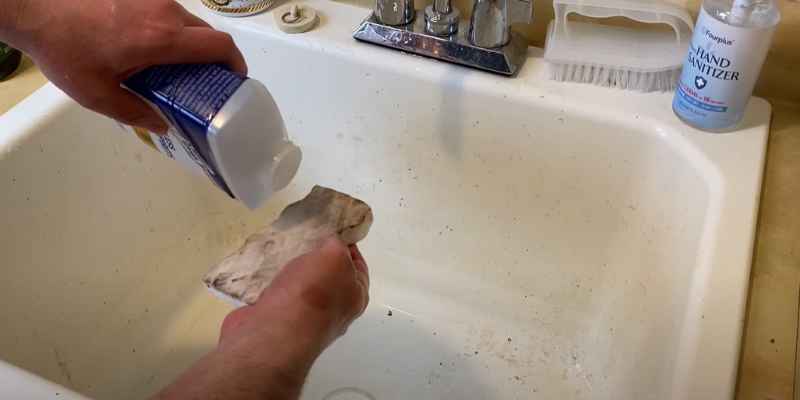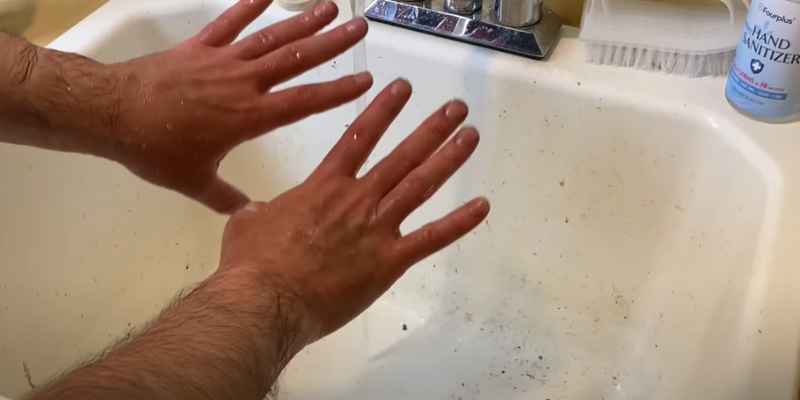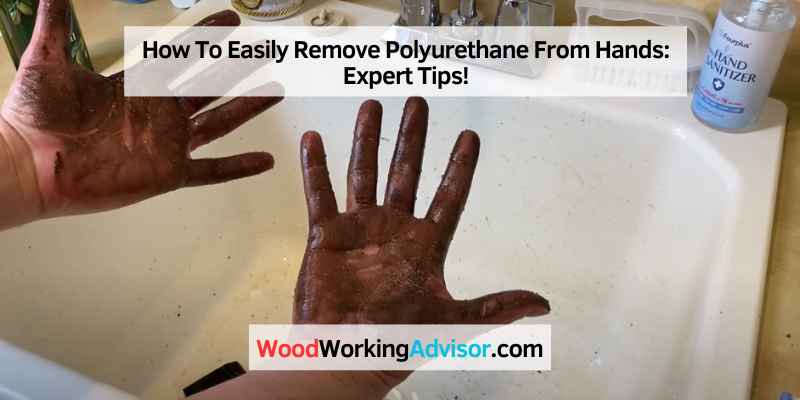To get polyurethane off hands, first, wipe off excess using a cloth or paper towel. Then, wash hands with soap and warm water, scrubbing gently.
Polyurethane can be a stubborn substance to remove from skin, especially if it has dried. However, with the right technique, you can successfully clean your hands. We will share effective methods to get polyurethane off your skin and leave your hands feeling clean and smooth.
Whether you have accidentally spilled polyurethane or have used it for a DIY project, these tips will help you remove the sticky residue easily. So, read on to discover the step-by-step process of getting polyurethane off your hands and regain their softness in no time.
Why Polyurethane Is Difficult To Remove From Hands
Polyurethane is a durable and versatile material commonly used in everyday products such as furniture, flooring, and adhesives. While its resistant properties make it a popular choice, it can be challenging to remove from your hands once you come into contact with it. Understanding the reasons behind its stubborn adherence to the skin can help you tackle this issue effectively.
Types Of Polyurethane
Polyurethane comes in various forms, each with its unique characteristics and level of adhesion. Some common types include:
- Solvent-based polyurethane
- Water-based polyurethane
- Oil-based polyurethane
- Two-component polyurethane
Each of these types may have different ingredients and formulations, which can affect its ability to stick to the skin.
Adhesion To Skin
Polyurethane is designed to adhere strongly to surfaces, which is one reason why it can be difficult to remove from the hands. Its adhesive properties allow it to tightly bond with the skin, making it resistant to simple washing or rubbing.
The level of adhesion can vary depending on factors such as the type of polyurethane, the amount applied, and how long it remains in contact with the skin. Additionally, factors like heat and moisture can enhance the adhesion, thereby making it even more challenging to remove.
Chemical Composition
The chemical composition of polyurethane contributes to its stubborn nature when it comes to removal from hands. Polyurethane is composed of organic polymers that create a strong and resilient structure. These chemical bonds provide durability and strength to the material, but also make it hard to break apart or dissolve.
In addition to its composition, polyurethane may contain other chemical additives such as curing agents, accelerators, or pigments, which can further complicate the removal process. These additives may alter the adhesive strength or affect the solubility, making it even more challenging to remove from your skin.
Considering these factors, the task of removing polyurethane from your hands requires a deliberate and targeted approach to effectively break the adhesive bond and dissolve the material.

Preventing Polyurethane From Getting On Your Hands
When working with polyurethane, it’s common to end up with the sticky substance on your hands. However, by taking some simple precautions, you can minimize the mess and make your cleanup easier. In this section, we will discuss three effective ways to prevent polyurethane from getting on your hands: wearing protective gear, using barrier creams, and applying hand sanitizer.
Wearing Protective Gear
One of the best ways to prevent polyurethane from getting on your hands is by wearing protective gear. This includes gloves, long-sleeved shirts, and pants. Gloves made from nitrile or latex are ideal for this purpose as they provide a good barrier against the sticky substance. Make sure the gloves fit well to avoid any gaps where polyurethane can seep through. Additionally, wearing long-sleeved shirts and pants will provide an extra layer of protection for your skin.
Using Barrier Creams
Another effective method for preventing polyurethane from sticking to your hands is by using barrier creams. These creams act as a protective layer between your skin and the polyurethane, making it easier to clean off later. Look for barrier creams specifically designed for industrial use, as they are formulated to repel substances like polyurethane. Apply a thin layer of the cream to your hands before starting any work with polyurethane, paying close attention to areas such as your palms and fingers.
Applying Hand Sanitizer
Hand sanitizer can also help prevent polyurethane from adhering to your skin. Before beginning your work, apply a small amount of hand sanitizer to your hands and rub it in, focusing on the areas that are most likely to come into contact with the polyurethane. The alcohol in the hand sanitizer can create a barrier between your skin and the polyurethane, making it easier to wash off later. However, it’s important to note that hand sanitizer should not replace proper handwashing after working with polyurethane.
Steps To Remove Polyurethane From Hands
Learn how to effectively remove polyurethane from your hands with these simple steps. Say goodbye to sticky residue and keep your skin clean and healthy.
Accidentally getting polyurethane on your hands can be quite annoying. It’s a sticky substance that doesn’t easily wash off with water alone. However, with a few simple steps, you can effectively remove polyurethane from your skin. The key is to act quickly, using household items or commercial hand cleaners. Read on to find out how.
Immediate Action
If you notice polyurethane on your hands, take immediate action. The longer the polyurethane sits on your skin, the more challenging it becomes to remove. Follow these steps:
- Wash with soap and warm water: Immediately wash your hands with warm water and soap. Use a mild soap, rubbing your hands together vigorously. This helps to loosen the polyurethane from your skin.
- Scrub gently: If the polyurethane doesn’t come off easily, use a soft-bristle brush or an old toothbrush to gently scrub your hands. Be careful not to scrub too vigorously, as it may irritate your skin.
Using Household Items
If the polyurethane persists after the initial wash, you can try using common household items to remove it. Here’s what you can do:
- Vegetable oil or olive oil: Apply a small amount of vegetable oil or olive oil to the affected area. Rub it gently, allowing the oil to break down the polyurethane. Rinse your hands with warm water and soap.
- Vinegar: Dampen a cloth or cotton ball with vinegar. Rub it onto the polyurethane and let it sit for a few minutes. Then, wash your hands with warm water and soap.
- Nail polish remover: If all else fails, you can use nail polish remover containing acetone. Apply a small amount to a cotton ball and rub the polyurethane. Rinse your hands thoroughly afterward.
Commercial Hand Cleaners
If household items don’t do the trick, you can turn to commercial hand cleaners specifically formulated to remove tough substances like polyurethane. Here are a few options:
| Product | Instructions |
|---|---|
| Gojo Fast Wipes | Dampen the wipe with water and gently scrub your hands. Rinse with warm water and soap. |
| Lava Heavy Duty Hand Cleaner | Apply a small amount to your hands and scrub thoroughly. Rinse with warm water. |
| Goo Gone Hand Cleaner | Apply a generous amount to your hands and rub thoroughly. Rinse with warm water and soap. |
Remember to follow the instructions provided by the manufacturer for these commercial hand cleaners.
By taking immediate action and using household items or commercial hand cleaners, you can effectively remove polyurethane from your hands. Remember, it’s essential to act quickly and avoid prolonged exposure to polyurethane.
Natural Remedies For Removing Polyurethane
Polyurethane is a versatile and durable substance used in various applications. However, if it gets on your skin, it can be quite challenging to remove. The good news is that you don’t need to resort to harsh chemicals to get it off. There are natural remedies that you can try at home to effectively remove polyurethane from your hands or skin. In this article, we will explore three effective methods using oil-based substances, citrus-based solutions, and vinegar and baking soda.
Oil-based Substances
If you find yourself with polyurethane on your hands or skin, you can use oil-based substances to help remove it. The oil helps break down the polyurethane, making it easier to wipe off. Here are a few oil-based options you can try:
- Coconut oil: Apply a generous amount of coconut oil to the affected area and rub it gently. Let it sit for a few minutes before wiping it off with a cloth or paper towel.
- Olive oil: Similar to coconut oil, olive oil can be used by applying it to the polyurethane and gently massaging it in. After a few minutes, wipe it off with a cloth.
- Vegetable oil: If you have vegetable oil handy, you can use it in the same way as coconut oil or olive oil to remove polyurethane from your skin.
Remember to wash your hands thoroughly with soap and water after removing polyurethane using oil-based substances.
Citrus-based Solutions
Citrus-based solutions are another effective way to remove polyurethane from your hands or skin. The natural acids in citrus fruit help break down the polyurethane and make it easier to remove. Here are a few citrus-based options you can try:
- Lemon juice: Squeeze fresh lemon juice onto the affected area and rub it gently. Let it sit for a few minutes before rinsing it off with water.
- Orange oil: Dab a cotton ball or cloth with orange oil and gently rub it on the polyurethane. After a few minutes, rinse it off with water.
- Grapefruit seed extract: Dilute grapefruit seed extract with water, and apply it to the polyurethane using a cloth or sponge. Let it sit for a few minutes before rinsing it off.
Be sure to rinse your hands thoroughly and moisturize after using citrus-based solutions to avoid any drying effects.
Vinegar And Baking Soda
Vinegar and baking soda offer a powerful combo for removing polyurethane from your hands or skin. Here’s how you can use them:
- Create a paste by mixing equal parts vinegar and baking soda.
- Apply the paste to the affected area and gently rub it in.
- Let it sit for a few minutes before rinsing it off with water.
- Repeat the process if necessary until the polyurethane is completely removed.
After using vinegar and baking soda, wash your hands thoroughly and apply moisturizer to keep your skin hydrated.
Tips For Caring For Your Hands After Removing Polyurethane
Looking to remove polyurethane from your hands? Follow these simple tips to effectively care for your skin after handling polyurethane.
Moisturizing
After removing polyurethane from your hands, it is crucial to moisturize your skin to prevent dryness and irritation. Here are some tips on how to effectively moisturize your hands:
- Apply a thick layer of moisturizer, preferably one specifically formulated for dry skin, to your hands.
- Massage the moisturizer into your skin until fully absorbed.
- For optimal hydration, apply moisturizer after every hand washing.
- Consider using hand creams or lotions with ingredients like shea butter, jojoba oil, or glycerin, as these can provide deep nourishment to your skin.
- Don’t forget to moisturize your cuticles as well, as they can also get affected by the polyurethane.
Avoiding Abrasive Scrubbing
While it may be tempting to vigorously scrub your hands to remove any lingering residue, this can further irritate your skin. Here’s how to avoid abrasive scrubbing:
- Instead of rubbing your hands together forcefully, use a gentle touch when washing them.
- Consider using a mild and moisturizing hand soap to prevent stripping away natural oils.
- If necessary, use a soft-bristled brush to gently scrub any stubborn spots, but avoid excessive pressure.
- Rinse your hands thoroughly with lukewarm water afterwards.
Regular Hand Care Routine
In addition to immediate care after polyurethane removal, maintaining a regular hand care routine can help keep your hands healthy and prevent future damage. Here’s what you can do:
- Always wear gloves when working with potentially harmful substances like polyurethane.
- Wash your hands with warm water and gentle soap, especially after exposure to any chemicals.
- Pat your hands dry with a clean towel instead of rubbing vigorously.
- Apply moisturizer regularly to keep your skin hydrated and supple.
- Protect your hands from extreme temperatures by wearing appropriate gloves in cold weather or when handling hot objects.
- Consider using a barrier cream or ointment before engaging in activities that may expose your hands to harsh chemicals or excessive moisture.
By following these tips for caring for your hands after removing polyurethane, you can help restore your skin’s health and keep your hands feeling soft and nourished.

Frequently Asked Questions Of How To Get Polyurethane Off Hands Skin
How Do You Get Polyurethane Off Your Skin?
To remove polyurethane from your skin, gently wash the affected area with soap and warm water. If the polyurethane is hardened, use a scraping tool to carefully lift it off. Avoid using harsh chemicals or sharp objects that could damage your skin.
How Do You Remove Pu Sealant From Hands?
To remove PU sealant from hands, use a solvent like acetone or nail polish remover. Soak a cloth or cotton ball in the solvent and gently rub the affected area. Rinse with warm soap and water afterward.
What Removes Dried Polyurethane?
To remove dried polyurethane, use a fine-grit sandpaper or chemical stripper. Sand the surface gently to remove the dried finish or apply a stripper following the manufacturer’s instructions.
How Do You Remove Urethane Adhesive From Skin?
To remove urethane adhesive from skin: Gently rub a mixture of warm water and mild soap over the affected area. Use a cloth or sponge to scrub off the adhesive, then rinse with water. Repeat if necessary until the adhesive is completely gone.
Conclusion
Removing polyurethane from your hands requires a few simple steps. By acting quickly and using household items like soap, oil, acetone, or vinegar, you can effectively eliminate the sticky substance from your skin. Remember to protect your hands with gloves or barrier creams to prevent future mishaps.
Keep these tips in mind to keep your hands polyurethane-free and ready for your next project. Happy crafting!


